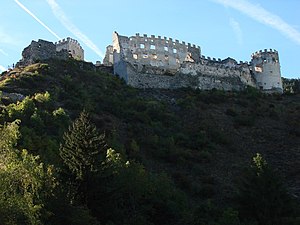Lichtenberg castle ruins
| Lichtenberg castle ruins | ||
|---|---|---|
|
View of the castle ruins from below |
||
| Alternative name (s): | Castel Montechiaro | |
| Creation time : | around 1200 | |
| Conservation status: | ruin | |
| Place: | Lichtenberg ( Prad ) | |
| Geographical location | 46 ° 38 '1.2 " N , 10 ° 33' 52" E | |
|
|
||
The Lichtenberg castle ruin is a ruined hilltop castle in Lichtenberg in the municipality of Prad ( South Tyrol ). The castle ruins are located above the village and offered the gentlemen at that time a good view of the Vinschgau and the Churburg in neighboring Schluderns .
The castle was first mentioned in 1259 as a sovereign property of the Counts of Tyrol , but it seems to have been founded as a noble base by the bailiffs of Matsch as early as 1200 . Around 1315 the complex was expanded and the castle hat was entrusted by the Tyroleans to the Lords of Lichtenberg, who had them decorated with epic frescoes that have become famous around 1400 . In addition to the fresco cycle at Runkelstein Castle, they represent the most important profane cycle in the Tyrolean region, were removed between 1908 and 1912 due to endangerment and brought to the Tyrolean State Museum in Innsbruck . A few frescoes remained in the ruin chapel and were restored in 2006. During excavations since 1994, some significant fragments of fallen frescoes have been recovered. Lichtenberg has been owned by the lords since the early 16th century, barons since 1573 and Count Khuen von Belasy since 1630 . They had acquired the castle from the Lords of Spaur in 1513 . In 1575 the Khuen-Belasy had a memorial chapel built on the hill of St. Christina, which is adjacent to the castle . In a " Spaunbrief " from 1493 the rights and duties between the lords of Stilfs and Lichtenberg Castle were laid down. In it, for example, the required taxes, hunting bans and grazing rules were recorded.
The Lichtenberg Castle Board of Trustees, founded in 1993, has primarily set itself the goal of preserving the Lichtenberg castle ruins, restoring them and saving them from deterioration. After the work has been completed, the castle will be used for cultural events that are accessible to the general public.
literature
- Hans Nothdurfter: The ruin Lichtenberg. Lana: Tappeiner 1995.
- Hans Nothdurfter: The ruin Lichtenberg. In: Rainer Loose (Ed.): Prad am Stilfserjoch. Lana: Tappeiner 1997, chap. 21, pp. 216-235.
- Oswald Trapp : Tiroler Burgenbuch. Volume I: Vinschgau . Publishing house Athesia, Bozen 1972, pp. 119-134.
Individual evidence
- ↑ a b c Hannes Obermair : Tirolensia in the National Museum in Prague. In: Preservation of monuments in South Tyrol 1991–1995. Published by the Bolzano Regional Monuments Office. Folio-Verlag, Vienna-Bozen 1997, pp. 277–290, here: pp. 282–289.
- ^ Johanna Thali: Writing as an image. Literature as part of noble self-portrayal in the wall painting cycle of Lichtenberg Castle (around 1400) . In: Wolfram-Studien XIX, Berlin 2006, pp. 269-300.
- ↑ Emil von Ottenthal , Oswald Redlich (edit.): Archive reports from Tyrol. Volume 1. Vienna / Leipzig 1888, p. 197 No. 949ff.
Web links
- Entry in the monument browser on the website of the South Tyrolean Monuments Office



